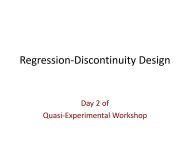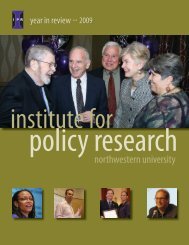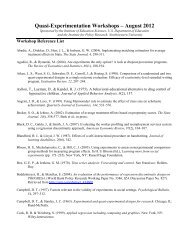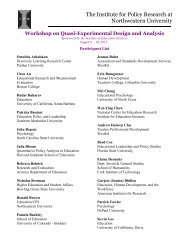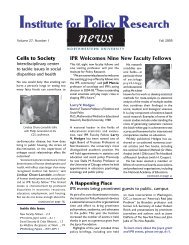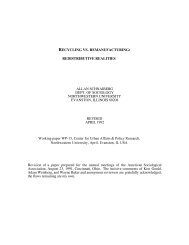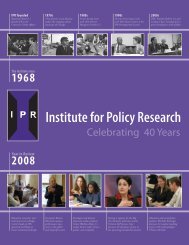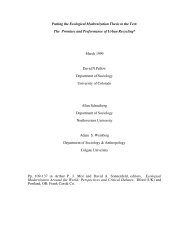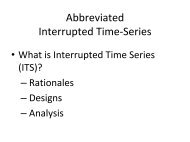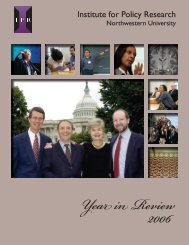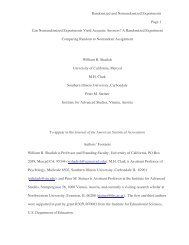Highlights of 2011 - Institute for Policy Research - Northwestern ...
Highlights of 2011 - Institute for Policy Research - Northwestern ...
Highlights of 2011 - Institute for Policy Research - Northwestern ...
You also want an ePaper? Increase the reach of your titles
YUMPU automatically turns print PDFs into web optimized ePapers that Google loves.
Urban <strong>Policy</strong> and Community Development<br />
Three Segregations and Concentrated<br />
Urban Poverty<br />
<strong>Research</strong> published in the American Sociological Review by<br />
Quillian finds that blacks and Hispanics tend to have neighbors<br />
from other racial groups who are disproportionately likely to<br />
be poor, even <strong>for</strong> high-income black and Hispanic households.<br />
This contributes importantly to the high poverty rates <strong>of</strong> the<br />
neighborhoods lived in by black and Hispanic families and<br />
to high poverty rates in the schools attended by black and<br />
Hispanic children. Quillian analyzed data from the 2000 census<br />
and found that the disproportionate poverty <strong>of</strong> blacks’ and<br />
Hispanics’ neighbors who are <strong>of</strong> other races plays an important<br />
role in creating racial disparities in neighborhood poverty. He<br />
develops a model to mathematically decompose sources <strong>of</strong><br />
poverty concentration as a product <strong>of</strong> demographic conditions<br />
including <strong>for</strong>ms <strong>of</strong> segregation. He finds that concentrated<br />
poverty in minority communities results from three segregations:<br />
racial segregation, poverty-status segregation within race, and<br />
segregation from high- and middle-income members <strong>of</strong> other<br />
racial groups. Past work has emphasized racial segregation and<br />
poverty-status segregation within race, but has missed the<br />
important role played by the disproportionately low-income<br />
levels <strong>of</strong> different-race neighbors <strong>of</strong> blacks and Hispanics.<br />
Quillian concludes that we need to consider the complex<br />
combination <strong>of</strong> race and income segregation in policies to<br />
reduce poverty concentration.<br />
Dynamic Models <strong>of</strong> Race and Income<br />
Segregation<br />
Housing trends in many U.S. cities clearly reflect decades <strong>of</strong><br />
racial segregation. But why do current residents continue to<br />
relocate along racial lines? Quillian is examining the modernday<br />
causes <strong>of</strong> urban racial segregation in a project with Elizabeth<br />
Bruch <strong>of</strong> the University <strong>of</strong> Michigan. One hypothesis is that<br />
a community’s racial make up directly affects the decision to<br />
move—or not to move—to a certain community, either due<br />
to prejudice or to a preference <strong>for</strong> living among neighbors <strong>of</strong><br />
one’s own race. A second hypothesis is that race only appears<br />
to matter because it is associated with other characteristics<br />
that do matter to households, such as school quality or poverty<br />
and crime rates. To test these hypotheses, Quillian and Bruch<br />
have developed new methods <strong>for</strong> modeling residential mobility<br />
across neighborhoods. Their discrete choice models incorporate<br />
multiple characteristics <strong>of</strong> destination neighborhoods, thus<br />
improving the model’s realism in replicating residential decision<br />
making. Preliminary results suggest that racial composition is a<br />
major factor in residential mobility decisions, even controlling<br />
<strong>for</strong> housing prices, economic status, and other factors <strong>of</strong> the<br />
communities to which people move. The research is supported<br />
by the National <strong>Institute</strong>s <strong>of</strong> Health.<br />
About the Program<br />
Lincoln Quillian, Chair<br />
IPR’s Urban <strong>Policy</strong> and Community Development<br />
faculty examine the shifting landscape <strong>of</strong> urban<br />
life, considering myriad issues related to today’s<br />
urban experience. Additionally, many IPR faculty<br />
work on projects that are closely tied to urban<br />
policy in areas such as education, housing, welfare<br />
re<strong>for</strong>m, community policing, and per<strong>for</strong>mance<br />
measurement and rewards.<br />
Inequality in France and the United<br />
States<br />
Focusing on inequalities found in neighborhoods and institutions<br />
between France and the United States, 25 researchers came<br />
together <strong>for</strong> a two-day workshop to discuss issues related to<br />
education, health, and employment. Held on June 23–24, the<br />
second annual transnational workshop was co-sponsored by IPR<br />
and Science Po’s Observatoire Sociologique du Changement<br />
(OSC) and took place at <strong>Northwestern</strong> University.<br />
The opening panel examined the relationship between<br />
neighborhoods and education. In France, a recent re<strong>for</strong>m now<br />
allows students to apply to go to any public school within their<br />
district. The hope was that it would send more disadvantaged<br />
students to better schools. Yet from interviews and a comparison<br />
<strong>of</strong> the re<strong>for</strong>m’s effects in two départements (counties), one<br />
more advantaged than the other, OSC sociologist Marco<br />
Oberti and pr<strong>of</strong>essor emeritus Edmond Préteceille find the<br />
re<strong>for</strong>m has instead destabilized the system. Not only has it<br />
failed so far to create more educational opportunities <strong>for</strong> lowincome<br />
students, it also seems to be contributing to growing<br />
stratification between schools.<br />
In the United States, levels <strong>of</strong> residential segregation are typically<br />
higher than in France. IPR social psychologist Thomas D. Cook<br />
and IPR postdoctoral fellow Coady Wing discussed the results<br />
<strong>of</strong> three experiments with the Housing Choice Voucher<br />
Program, also referred to as “Section 8,” the main U.S. housing<br />
program <strong>for</strong> low-income families. Averaging around $7,600<br />
per family a year, this federal program amounts to $40 billion<br />
55



